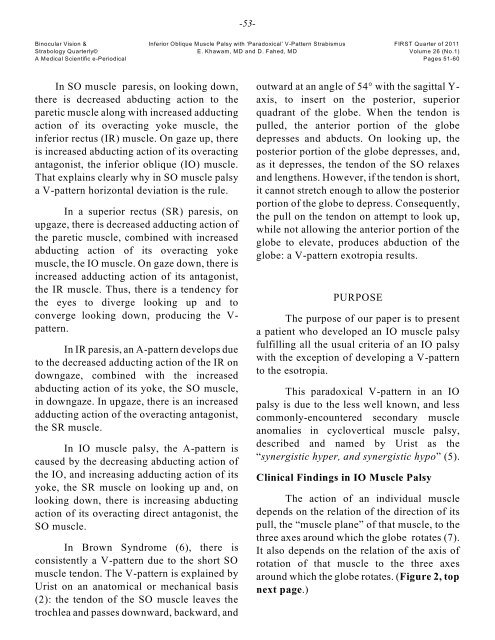Correspondence - ICO Library
Correspondence - ICO Library
Correspondence - ICO Library
Create successful ePaper yourself
Turn your PDF publications into a flip-book with our unique Google optimized e-Paper software.
-53-<br />
Binocular Vision & Inferior Oblique Muscle Palsy with ‘Paradoxical’ V-Pattern Strabismus FIRST Quarter of 2011<br />
Strabology Quarterly© E. Khawam, MD and D. Fahed, MD Volume 26 (No.1)<br />
A Medical Scientific e-Periodical Pages 51-60<br />
In SO muscle paresis, on looking down,<br />
there is decreased abducting action to the<br />
paretic muscle along with increased adducting<br />
action of its overacting yoke muscle, the<br />
inferior rectus (IR) muscle. On gaze up, there<br />
is increased abducting action of its overacting<br />
antagonist, the inferior oblique (IO) muscle.<br />
That explains clearly why in SO muscle palsy<br />
a V-pattern horizontal deviation is the rule.<br />
In a superior rectus (SR) paresis, on<br />
upgaze, there is decreased adducting action of<br />
the paretic muscle, combined with increased<br />
abducting action of its overacting yoke<br />
muscle, the IO muscle. On gaze down, there is<br />
increased adducting action of its antagonist,<br />
the IR muscle. Thus, there is a tendency for<br />
the eyes to diverge looking up and to<br />
converge looking down, producing the V-<br />
pattern.<br />
In IR paresis, an A-pattern develops due<br />
to the decreased adducting action of the IR on<br />
downgaze, combined with the increased<br />
abducting action of its yoke, the SO muscle,<br />
in downgaze. In upgaze, there is an increased<br />
adducting action of the overacting antagonist,<br />
the SR muscle.<br />
In IO muscle palsy, the A-pattern is<br />
caused by the decreasing abducting action of<br />
the IO, and increasing adducting action of its<br />
yoke, the SR muscle on looking up and, on<br />
looking down, there is increasing abducting<br />
action of its overacting direct antagonist, the<br />
SO muscle.<br />
In Brown Syndrome (6), there is<br />
consistently a V-pattern due to the short SO<br />
muscle tendon. The V-pattern is explained by<br />
Urist on an anatomical or mechanical basis<br />
(2): the tendon of the SO muscle leaves the<br />
trochlea and passes downward, backward, and<br />
outward at an angle of 54° with the sagittal Y-<br />
axis, to insert on the posterior, superior<br />
quadrant of the globe. When the tendon is<br />
pulled, the anterior portion of the globe<br />
depresses and abducts. On looking up, the<br />
posterior portion of the globe depresses, and,<br />
as it depresses, the tendon of the SO relaxes<br />
and lengthens. However, if the tendon is short,<br />
it cannot stretch enough to allow the posterior<br />
portion of the globe to depress. Consequently,<br />
the pull on the tendon on attempt to look up,<br />
while not allowing the anterior portion of the<br />
globe to elevate, produces abduction of the<br />
globe: a V-pattern exotropia results.<br />
PURPOSE<br />
The purpose of our paper is to present<br />
a patient who developed an IO muscle palsy<br />
fulfilling all the usual criteria of an IO palsy<br />
with the exception of developing a V-pattern<br />
to the esotropia.<br />
This paradoxical V-pattern in an IO<br />
palsy is due to the less well known, and less<br />
commonly-encountered secondary muscle<br />
anomalies in cyclovertical muscle palsy,<br />
described and named by Urist as the<br />
“synergistic hyper, and synergistic hypo” (5).<br />
Clinical Findings in IO Muscle Palsy<br />
The action of an individual muscle<br />
depends on the relation of the direction of its<br />
pull, the “muscle plane” of that muscle, to the<br />
three axes around which the globe rotates (7).<br />
It also depends on the relation of the axis of<br />
rotation of that muscle to the three axes<br />
around which the globe rotates. (Figure 2, top<br />
next page.)









